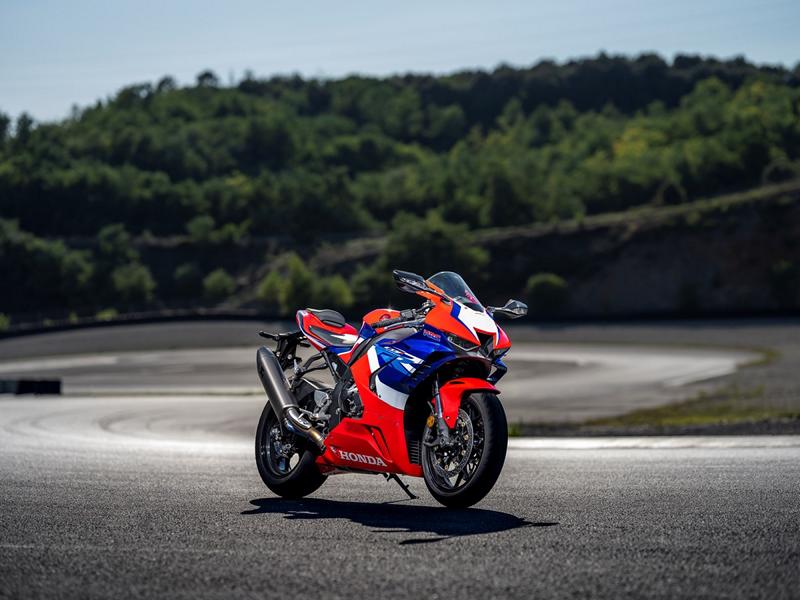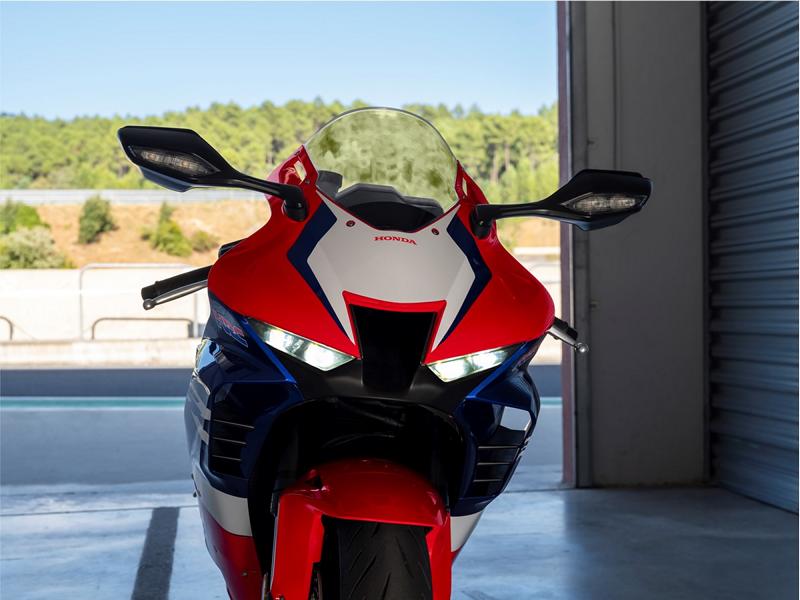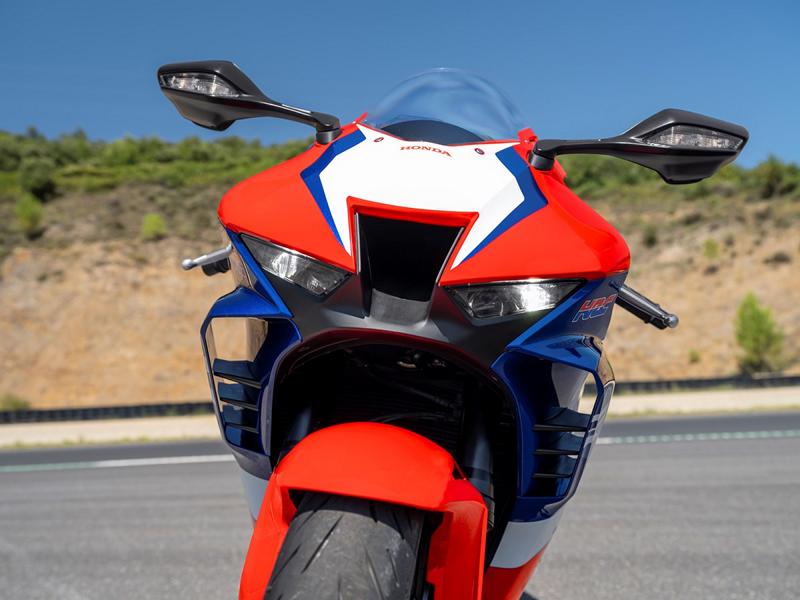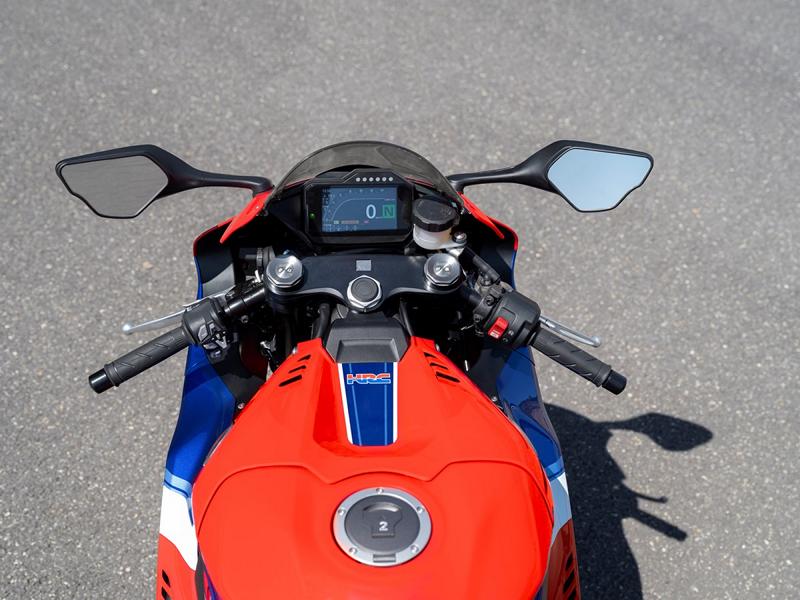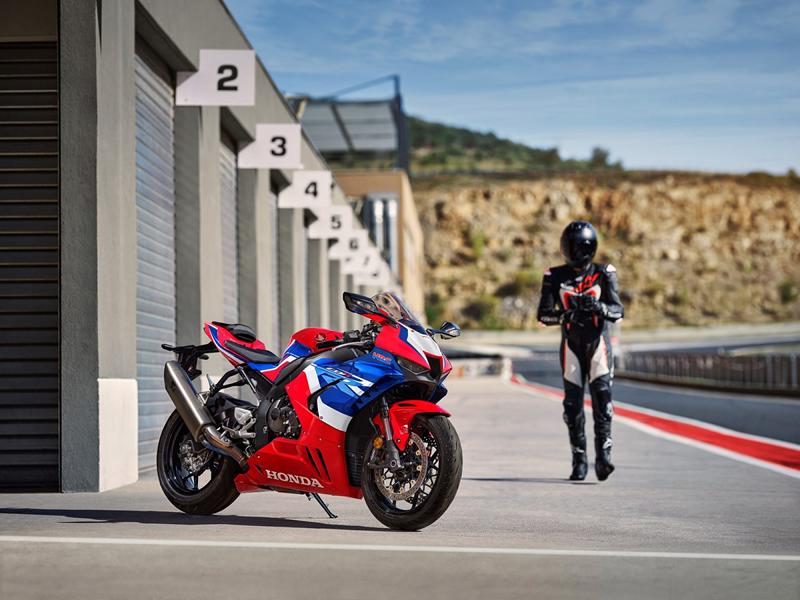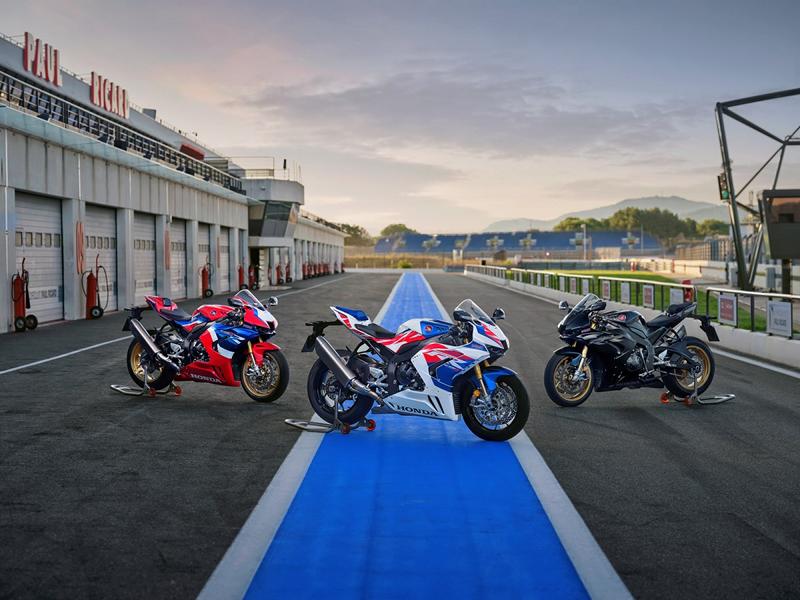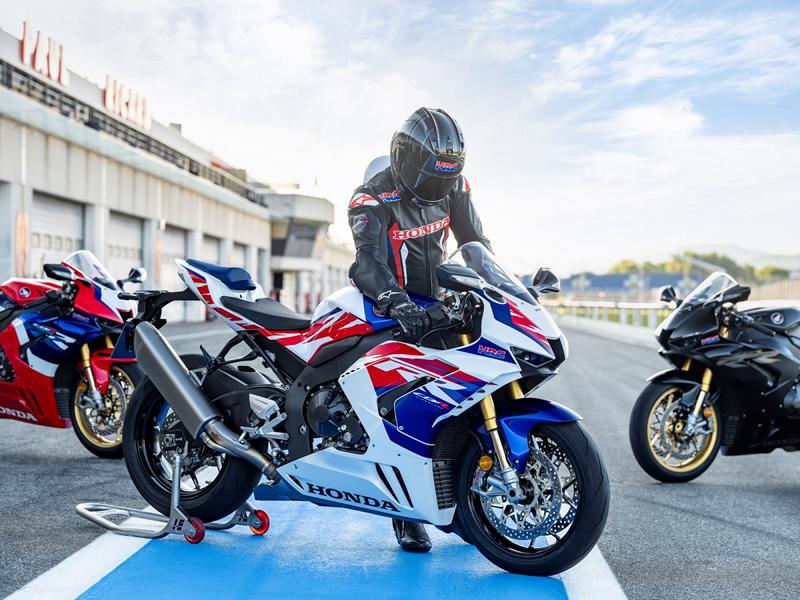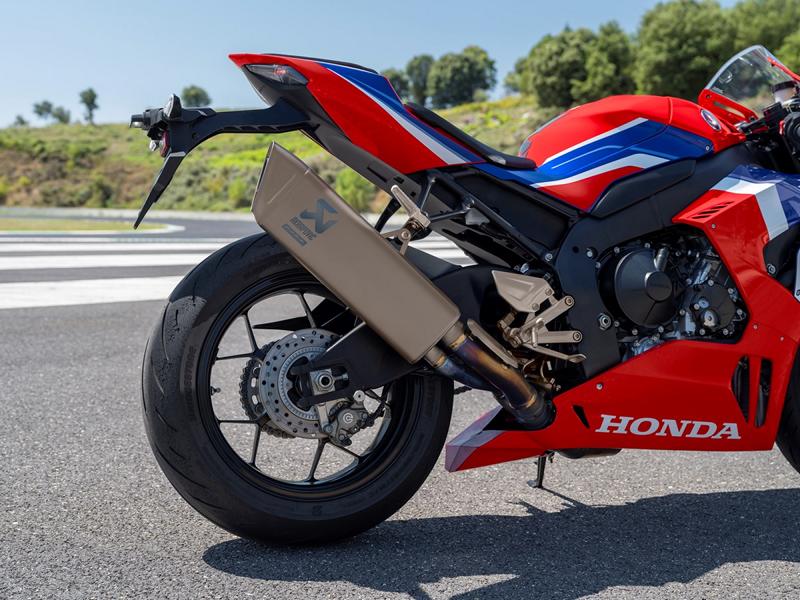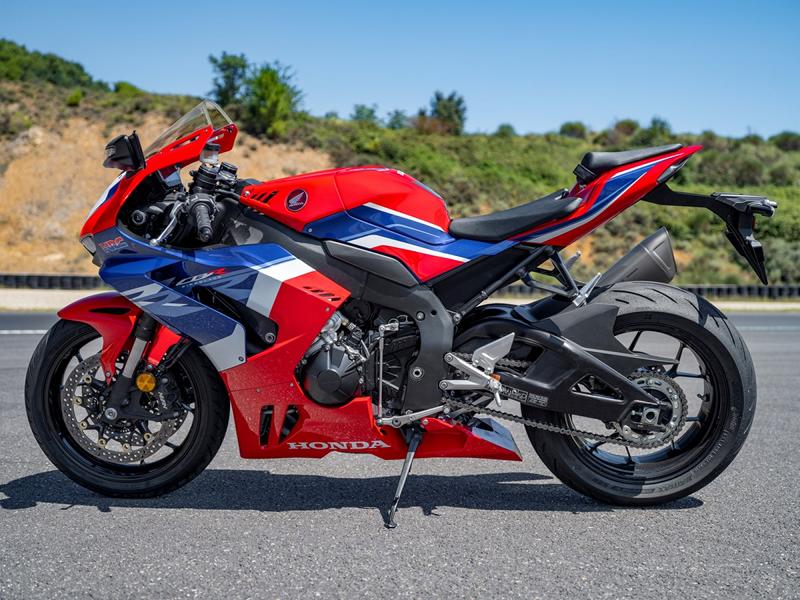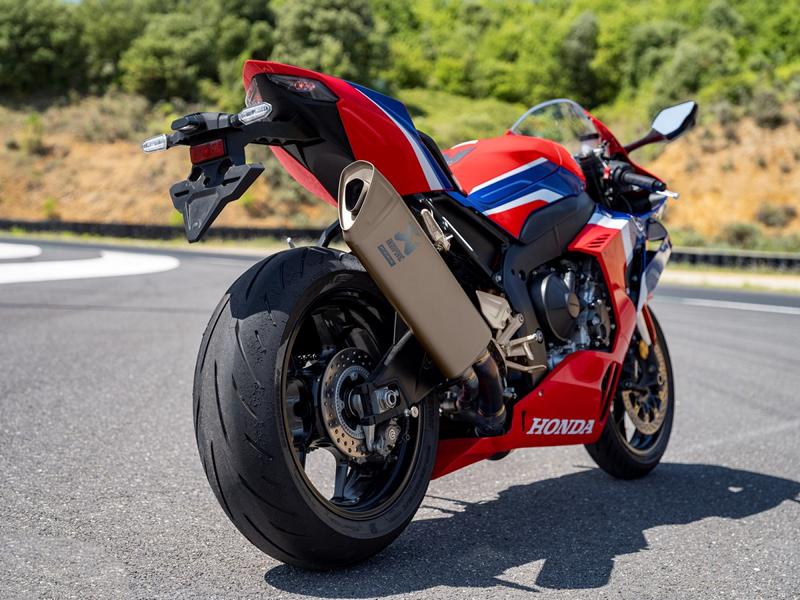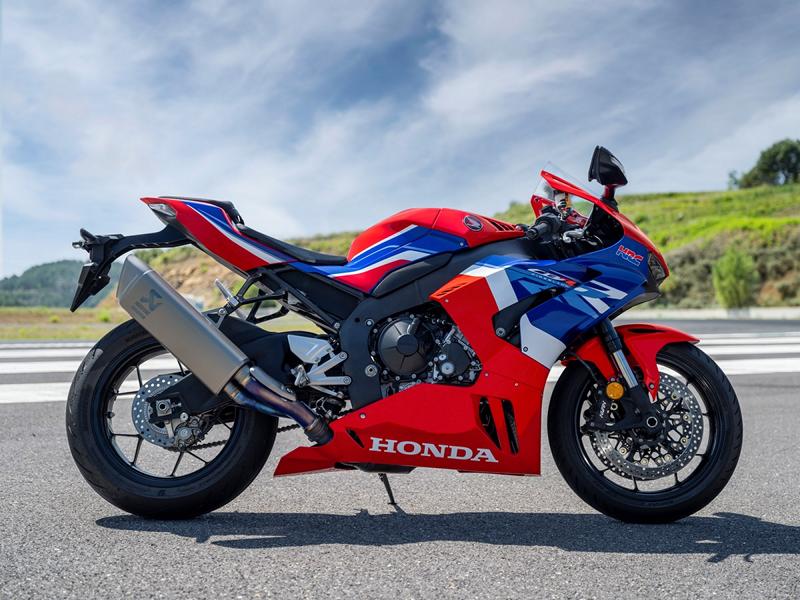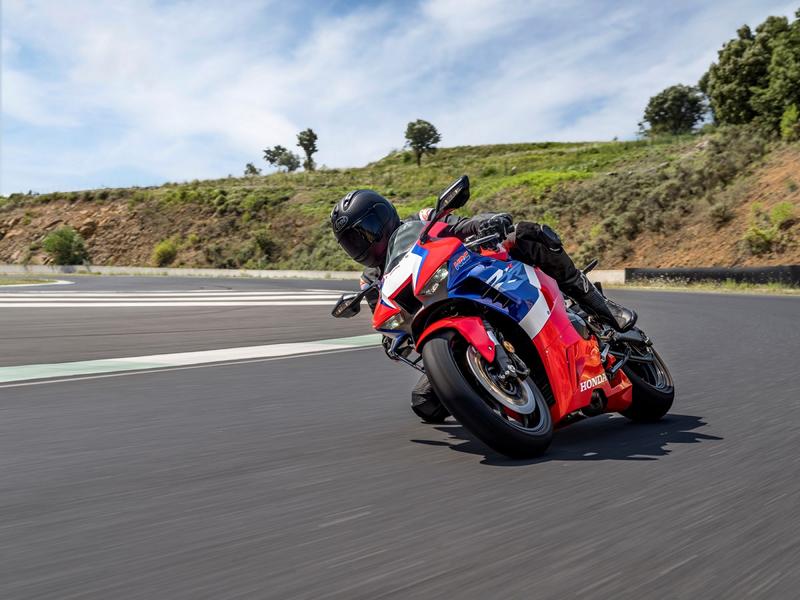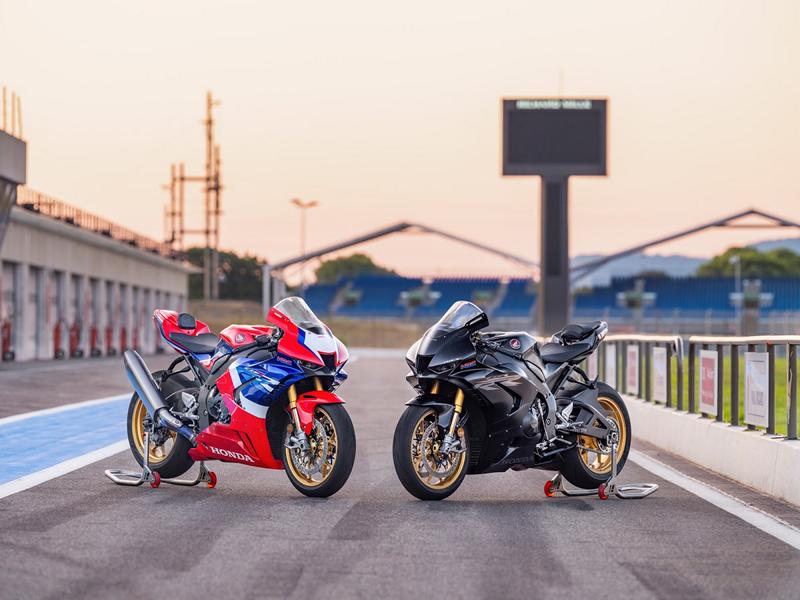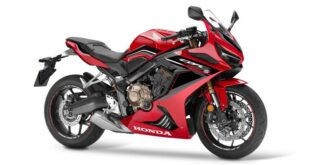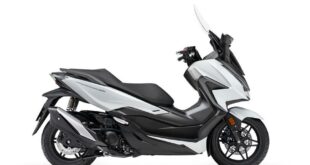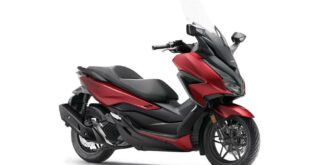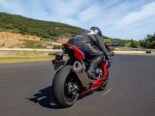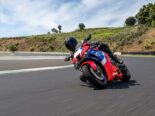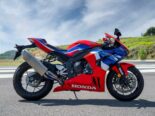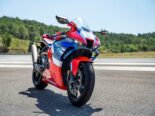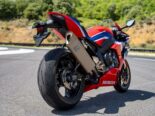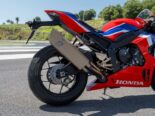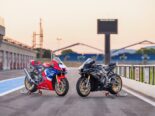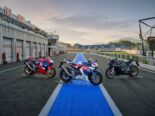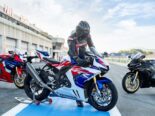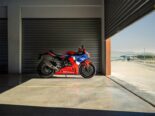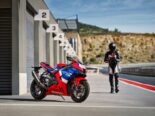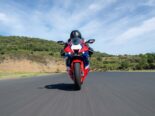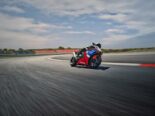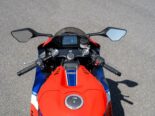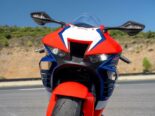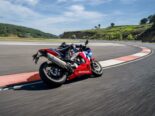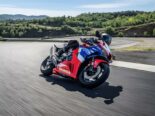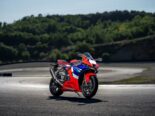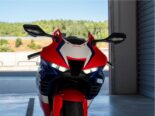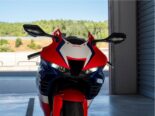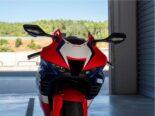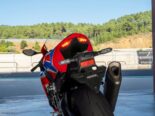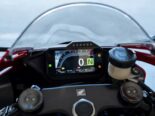Honda's Fireblade enters its 30th year of production. The 1000 model year CBR2020RR-R Fireblade is a completely new developed machine and uncompromisingly optimized for use on the racetrack. In the further development for the 2022 vintage with the 217,6 HP / 160 kW in-line four-cylinder engine, Honda sought to improve acceleration through optimized torque at medium speeds. For this purpose, the inlet ducts, airbox, airbox funnel and partially the exhaust have been revised in order to generate more punch in the middle area. Furthermore, a sprocket with three more teeth (now 43 teeth) has been installed in order to generate more powerful acceleration dynamics through all gears, while at the same time maintaining top performance at high speeds.
CBR1000RR-R Fireblade & Fireblade SP
The HSTC traction control is also newly tuned - with feedback from HRC drivers - for optimized functionality on the rear wheel and more sensitivity when pulling the throttle. New pistons (different material, new surface finish) on the Nissin brake calipers improve braking performance and consistency under racing conditions. The other chassis components remain unchanged: aluminum bridge frame, RC213V-S-Style aluminum swing arm, six-axis gyro sensor, 3-stage HESD steering damper and the Showa wheel suspensions front and rear.
The fairing features aero winglets, derived from Honda's MotoGP machines, to generate additional downforce. Full color TFT display and smart key system round off the high-tech package of the CBR1000RR-R Fireblade.
Content:
- Preface
- Model overview
- Equipment features
- Accessories
- Technical data
- Preface
It is undisputedly an icon in the motorcycle market: Since the original model, the CBR900RR from 1992, the Fireblade has developed into a 1000 cubic super sports car in a class of its own. It also provided the basis for successful racing machines - on circuits right through to the streets of the Isle of Man.
But times and also the demands of competition are changing. Therefore, Honda opened a new chapter in the history of the Fireblade for 2020 and created radically new super athletes: the CBR1000RR-R Fireblade and the CBR1000RR-R Fireblade SP *. With the involvement of the Honda Racing Corporation, both were developed with one goal - to lift the legend to a new, excitingly super sporty level.
It borrowed from the engine and chassis technology of the approved MotoGP machine from Honda, the RC213V-S. Complemented by aerodynamic solutions from the MotoGP racer RC213V, the new Fireblade marked a new development when it was released, which was uncompromisingly designed for optimal racetrack performance in terms of engine, handling and aerodynamics.
2022 is an important anniversary for Honda as it marks 30 years of the globally successful Fireblade series. A large number of optimized details and updates help to improve the acceleration and torque, the control of the HSTC traction control and the stability of the brakes in the youngest year. To celebrate three decades, the CBR1000RR-R Fireblade SP 30th Anniversary * will be available in a limited edition with a special paint and pay homage to the design of the 1992 original Fireblade.
* See the separate press kit for the CBR1000RR-R Fireblade SP
- Model overview
The in-line four-cylinder engine of the Fireblade develops 217,6 HP (160 kW) at 14.500 rpm, the maximum torque is 112 Nm at 12.500 tours.
The updates for the 2022 model year are aimed at improved torque and optimized acceleration. In return, the sprocket was given three more teeth (now 43 teeth) in order to generate more torque through all gears, while maintaining top performance at high speeds. Both the airbox and the inlet funnel received a portion of fine-tuning to facilitate an optimized flow. The inlet channels have also been adapted accordingly, while the flow to and through the catalytic converter has also been improved.
A reduced return spring force of the Throttle By Wire throttle grip serves to improve the linearity when pulling up. The feedback from experienced racing drivers - including the HRC World SBK team from Honda - helped to refine the coordination of the multi-level HSTC traction control in order to offer Fireblade drivers an optimized level of grip as well as a further improved feeling when operating the throttle with increased acceleration potential to be able to.
As usual, three pre-configured driving modes cover most conditions for full adjustment of power, engine braking, wheelie control and HSTC traction control. The electronics package also includes launch control as standard.
The motor uses a short-stroke layout with identical values for bore and stroke as in the RC213V. In addition a semi-cam camshaft drive, rocker arms for valve actuation and titanium connecting rods. Friction-reducing technologies from the RC213V are used as well as oil spray nozzles for piston cooling and a lower bypass channel in the water jacket of the cylinder bank. The ram air system in the front fairing leads through the steering head directly into the airbox. The 4-2-1-layout manifolds are ovalized and the exhaust system was developed in collaboration with Akrapovic.
The aluminum bridge frame uses the rear part of the motor as the upper pivot point of the Pro-Link rocker arm and the swing arm is based on the design of the RC213V-S. In the layout, the rigidity, weight distribution and steering geometry have been carefully adapted to the engine output - always with the aim of increasing the grip on the front and rear wheels and improving the feeling for the driver.
The gyro sensor unit (Inertial Measurement Unit - IMU) measures the forces occurring in the driving dynamics over six axes and thus provides the database for the electronic driving aids and systems. It also controls the function of the three-stage steering damper (Honda Electronic Steering Damper - HESD) in rod design.
A Showa 43 mm Big Piston telescopic fork is used on the front wheel, which is coordinated with the Showa Balance Free Rear Cushion Light shock absorber on the rear wheel. The double disc brake is equipped with Nissin four-piston calipers, the brake pistons of which have been given a new material composition and coated surfaces with a view to increased heat resistance. The braking system also shines with a state-of-the-art cornering ABS, which can also be adjusted for use on the racetrack.
The CBR1000RR-R Fireblade benefits from the aerodynamic components of the MotoGP-Honda RC213V. These include additional wings (winglets) to increase the contact pressure and thus the braking stability. The seating position on the motorcycle is also designed to be sporty. The 5 inch TFT display offers intuitive operation with the help of a four-way switch on the left handlebar fitting. There is also a practical smart key system on board. The 2022 CBR1000RR-R Fireblade is available in the color "Grand Prix Red" (with a white start number field in front).
- Features
3.1 Engine
- Short-stroke four-cylinder in-line engine for maximum performance at high speeds; 217,6 PS (160 kW) at 14.500 tours and 112 Nm at 12.500 rpm.
- Sprocket with 43 teeth for improved pulling power and optimized acceleration
- Airbox, intake tract and intake funnel modified for increased gas throughput
- 4-2-1 exhaust with redesigned catalytic converter center section
The Fireblade's 1000 cubic four-cylinder engine was developed with the assistance of MotoGP engineers from HRC. The maximum output is 217,6 PS (160 kW) at 14.500 rpm, the maximum torque 112 Nm at 12.500 rpm. To achieve these numbers, large valve cross-sections, efficient combustion and friction-reducing tricks are necessary. The RR-R has the same bore and stroke values as the RC213V: 81 mm and 48,5 mm. The compression has been increased from 13,2: 1 to 13,4: 1.
The air is supplied to the engine via a dynamic pressure system, the inlet of which is at the top of the front fairing and the opening size of which corresponds to that of the RC213V MotoGP bikes. Specially arranged ribs (so-called "turbulence generators") on the right, left and above the duct entrance ensure the best possible inflow of air with minimal impact on vehicle handling. The flow-optimized design of the inner walls ensures a constant flow of air at high speeds as well as when accelerating.
In order to enable stable power delivery over a wide speed range, the air flows directly through the steering head into the airbox. The straight air flow is made possible by the use of the smartkey system, as this eliminates the need for the ignition lock unit, which would otherwise be in the way. To ensure the required air volume, the throttle valve diameter is 52 mm.
New for the 2022 RR-R model: The "dirty" side of the air filter has been adapted to control the direction of the intake air separation and the generation of vortices to ensure a continuous flow of air when the throttle valve is open. On the “clean” side, filtered air is now fed into the slash-cut inlet funnel, with # 2 and # 3 shortened by 15 mm. In addition, the inside diameter of the inlet ducts was partially narrowed in order to increase the flow rate, in order to improve the filling efficiency with ignitable mixture and thus the performance in the middle range.
With the same goal of stronger acceleration in the middle range (through all gears) while maintaining high speeds, the rear sprocket was provided with three more teeth (from 40 to 43 teeth). The exhaust manifolds reflect the intake side and have an oval cross-section. On the 2022 Fireblade, the 4-2-1 exhaust has a redesigned center section that allows better flow through the catalytic converter for an optimized gas flow.
Akrapovic was a partner in the development of the exhaust system made of titanium. Compact design and low weight contribute to mass centralization and the maximum lean angle on the right-hand side. The flap system was also developed with Akrapovic to provide plenty of torque at low speeds as well as a lot of power at high speeds. In addition, a “valve stopper” prevents possible exhaust gas leaks when closed and at the same time reduces the noise level.
The inlet valves have a diameter of 32,5 mm, the outlet is 28,5 mm. The valves are operated by rocker arms. The valve angle on the inlet side has been reduced from 11 to 9 degrees. This improves the efficiency of the combustion by reducing the surface area of the combustion chamber. At the same time, the degree of flow with the gas / air mixture is increased.
MotoGP know-how is omnipresent: The use of diamond-like carbon (DLC) coating on the cams further reduces friction, as with the RC213V-S. This process is being used for the first time on a production motorcycle and results in a 35 percent reduction in friction losses in the valve train compared to cams that are not DLC-coated.
The valve train is driven by a semi-cam system. In order to achieve such impressive performance at high speeds and high cam lift, the chain is driven by the timing gear on the crankshaft via the cam idler - this shortens the length.
Forged, lightweight connecting rods made from TI-64A titanium (a material developed by Honda) save 50 percent in weight compared to those made from chrome-molybdenum steel. In addition, fastening bolts made of HB 149 chrome-molybdenum-vanadium steel (Cr-Mo-V, also a Honda development) are used, which do not have fastening nuts.
To ensure durability, the same configuration as the RC213V-S is used on the sliding surfaces of the connecting rods. On the connecting rod eyes these are made of scraped C1720-HT beryllium copper (because of its reliability at high speeds), while the surfaces on the connecting rod foot are treated with DLC.
The pistons are forged from A2618 aluminum (like those on the RC213V-S) for strength and durability. Each piston is five percent lighter than its predecessor. To ensure wear resistance at high speeds, the piston skirts have a special coating based on Teflon and molybdenum. There is also a nickel-phosphorus coating for the groove of the locking ring.
Multi-point nozzles are used to cool the pistons, which spray cooling engine oil at several points on the piston crown during each combustion cycle. If this is not necessary at low speeds, ball valves on the nozzles interrupt the flow of oil, thus limiting oil pressure loss and friction.
In order to reduce the bore distortion (and thus the friction), the cylinders have an integrated lower bypass. In this way, coolant from the radiator is fed into the main water jacket, while uncooled water is used in the lower area. The effect is a lower and more even temperature at all points of the cylinders than in the previous engine. There is also no need for an external hose.
To reduce the overall width, the engine is started by turning the clutch main shaft and not the crankshaft. This design allows for a more compact crankshaft, and the dual use of the primary gear - which in turn is smaller and has fewer teeth to transmit the rotation of the starter - saves additional space. In addition, the engine is shorter because the distance between the crankshaft, countershaft and main shafts is reduced. Another plus of the compact packaging: The rear part of the engine block can serve as the upper attachment of the strut bell crank.
3.2 Motor electronics
- Upgrade of HSTC traction control for refined function on the rear wheel and optimized feel when pulling the throttle, developeAccording to the feedback from HRC racing drivers
- Throttle By Wire throttle with reduced return spring force for a linear, more controllable function when the throttle is pulled up
- Three pre-configured driving modes plus the option of power output, engine braking and wheelie-Control to be set individually in user mode
- Launch Control as standard equipment
The 2017 CBR1000RR was the first inline four-cylinder from Honda to be equipped with an electronic throttle by wire. Derived from and developed from the system used on the RC213V-S, it controls the angle of the throttle valve relative to the position of the throttle grip to ensure linear power delivery. This provides precise throttle control and a natural feeling in the driver's throttle hand. For the 2022 vintage, the pulling force of the throttle return spring was reduced in order to make the responsiveness and linearity of the throttle operation more comfortable for the driver.
In connection with this: The HSTC traction control of the Fireblade can be set in 9 levels and can be switched off. The system of the 2020 CBR1000RR-R Fireblade has a slip rate control (whose intervention is based on the extent to which the front and rear wheels rotate at different speeds) in order to prevent excessive wheelspin in a gentle and easily controllable manner. For the Fireblade year 2022, the software control system (about the time of intervention and the slip rate) was re-adjusted in order to make the traction control work even finer and better. For this purpose, the feedback from the professional racing drivers at HRC was used.
There are three standard driving modes, with options for changing engine power and performance characteristics. The parameter Power (P) works in levels 1 to 5. The engine brake (EB) controls the power with the throttle lever closed through levels 1 to 3, with 1 being the strongest engine brake. Wheelie Control (W) can be set to levels 1 to 3 (plus inactive), with 1 standing for the least amount of interference.
The Wheelie Control uses dynamic information provided by the gyro sensor of the CBR1000RR-R, as well as the values of the speed sensors for the front and rear wheels, in order to maintain the torque at the rear wheel in a controlled manner and to control wheelies without impairing the acceleration.
The CBR1000RR-R is also equipped with a launch control for racing starts. This feature limits the engine speed to 6.000, 7.000, 8.000 or 9.000 tours - even with the throttle valve wide open - so that the driver can concentrate solely on disengaging the clutch when the start light turns green.
3.3 chassis
- Nissin four-piston brake calipers with a new material composition for the brake pistons and a special surface treatment for optimized track braking performance
- Aluminum frame and swing arm with a specific balance of rigidity for precise handling and an optimized grip feeling
- Six-axis gyro sensor (Inertial Measurement Unit - IMU) from Bosch for the exact recording of the driving dynamics processes as well as the control of the electronic driving aids and systems
- Fully adjustable suspension elements: Showa 43 mm Big Piston Fork (BPF) front fork and Balance Free Rear Cushion Light (BFRC-Light) strut
- Honda Electronic Steering Damper (HESD): three-stage adjustable rod steering damper from Showa with gyro sensor-based control
The bridge frame is made of 2 mm thick aluminum and enables the rigidity balance to be precisely adjusted. During production, after the four main frame components have been welded, the motor is screwed in six places, which is beneficial for the handling of the machine. Vertical and torsional stiffness are carefully matched to give the rider the most perfect possible feeling for the motorcycle.
The wheelbase, extended by 5 millimeters, is now 1,460 mm, the steering head angle and caster are still 24 ° and 102 mm. The weight with a full tank is 201 kg. The front / rear weight distribution is 53/47%, while the center of gravity supports rapid changes in lean angle.
The swing arm, based on the model of the RC213V-S, is made up of 18 individual stamped aluminum parts with different wall thicknesses and measures 622,7 mm in length. As with the frame, the horizontal and vertical stiffness are carefully balanced to create as much grip and a better feeling of control as possible.
For optimal frame rigidity (and to save weight) the upper bracket of the Pro-Link suspension is attached to the rear of the engine block via a mount. This decouples the rear suspension from the steering head, which improves stability at high speeds and the feeling of traction of the rear wheel.
Round, thin-walled aluminum tubes form the compact subframe. This is attached to the frame from above (not from the sides) in order to be able to make the tank and seat area slimmer, which enables an aerodynamically efficient seating position. The seat height is 830 mm, with the handlebar position further forward for better leverage. The footrests are positioned to the rear and upwards to match.
The six-axis gyro sensor from Bosch enables precise calculation of driving dynamics (acceleration, deceleration, inclination, gyroscopic and tilting movements) and thus precise calculation and control of driving behavior.
The Fireblade is equipped with an electronically controlled steering damper (Honda Electronic Steering Damper - HESD) from Showa. The compact part in rod construction is attached to the underside of the steering head and to the lower triple clamp. The HESD is controlled by wheel speed sensors and gyro sensor values, three basic settings are possible.
The large damping volume of the Showa 43 mm Big Piston Fork upside-down fork results in reduced hydraulic pressure during compression and rebound. This results in minimal play, precise responsiveness and gentle damping, which maximizes tire contact with the asphalt. Spring preload as well as compression and rebound damping are fully adjustable. In addition, the fork of the RR-R is a little longer, which creates more freedom for geometry changes on the racetrack.
The rear wheel is damped by a fully adjustable Showa Balance Free Rear Cushion Light (BFRC-Light) shock absorber unit. Instead of a conventional single-tube arrangement, the BFRC-Light component uses a two-tube design that consists of the damper housing and an additional inner cylinder. The damper piston itself has no valves, instead the damping force is generated when the displaced oil flows through a separate damping component. As a result, pressure changes within the damper are continuously controlled and the damping behavior and the reaction are improved. In this way, a smooth onset of force is achieved during the damping process. For this purpose, when changing from tension to compression, a constant damping force is generated through uniform pressure changes.
Radially bolted Nissin four-piston front brake calipers ensure the best braking performance and long-term reliable function, as required especially in Superstock races under heavy loads. These use a new piston material and surface treatment to optimize heat dissipation and maintain a good lever feel. The brake calipers access discs with a diameter of 330 mm and a thickness of 5 mm. The same Brembo double-piston brake caliper is used on the rear wheel as on the RC213V-S.
A rear wheel lift detection and the ABS-controlled braking force for lean angles help build confidence when turning. The CBR1000RR-R has two different modes for this: The sport mode is optimized for road use - with high braking power and less lean angle - while the track mode calculates the braking power for use on racetracks - and at significantly higher speeds.
A 6/200-ZR55 tire is mounted on the 17 inch wide rear wheel rim, which minimizes the change in the chassis geometry when changing from road to racing tires. The front rim is fitted with a 120/70-ZR17 tire.
3.4. Aerodynamics and equipment
- Fairing, windshield and mudguard minimize the frontal area and air resistance; the flat tank hood supports a sporty sitting position
- Winglets modeled on the RC213V MotoGP machine improve braking stability and reduce the tendency to wheelies
- 5-inch color TFT display and four-way switch on the left handlebar make it easier to control the assistance systems
- Honda Smartkey System for useful everyday convenience
The design of the full fairing is not a mere exercise in style, but supports the aerodynamics of the CBR1000RR-R Fireblade with a low drag coefficient (the best in the Supersport category, with a driver in racing stance), reduced lift when accelerating and improved braking stability.
The cover on the top of the tank is set low in order to reduce the frontal area behind the fairing when the driver is lying down. The windshield, which is arranged at an angle of 35 degrees (which already has low air resistance), ensures an even flow of air over the driver and seat paneling. The upper left / right fairing slots reduce yaw and rolling resistance when turning.
To make steering easier, a convex surface on each side of the fender directs airflow from the front wheel towards the fairing sides. The air flow for the radiator and oil cooler is also optimized through the targeted use of the vortices that are created when the air flows around the front wheel.
The fairing keel is extended towards the rear tire and shaped in such a way that the air is diverted downwards on both sides. This has two effects: in dry conditions, less air hits the tire, which reduces air resistance; when it is wet, less water hits the tire, which improves grip. In order to minimize the air resistance in the area of the boots, the rear wheel cover is also carefully tailored. As a result, air that flows upwards from below on the sides of the swing arm is diverted and thus the rear lift is reduced.
The bottom line is that the RR-R Fireblade achieved a record of 0,270 as the drag coefficient (cw-Value).
In order to generate downforce on racetracks while maintaining a minimal frontal area, the CBR1000RR-R uses additional wings (winglets) that effectively generate the same downforce as the 213 RCV2018V MotoGP racing machine increased stability when braking and turning into corners.
Inside the left and right fairing ducts, three wings are arranged in a vertical line, as this arrangement (staggered vertically and flat in the longitudinal direction) does not have any negative influence on the yaw and roll behavior when turning. In addition, the constant distance between the rear wing tips and the inner fairing wall limits the separation of the air flow and generates maximum downforce.
The wing angle enables the compensation of opposing downforce (right vs. left) that can result from the yaw movement when turning. This supports a stable behavior of the motorcycle. The flow velocities above and below the wings differ. This prevents air from building up on the sides of the fairing and impairing handling.
The CBR1000RR-R is equipped with a 5 inch TFT screen, the display of which is completely customizable. A four-way switch that is quick and easy to use is integrated on the left handlebar fitting. The upper / lower buttons are responsible for the parameters of the driving modes, while the left / right buttons control the information and the screen display.
Thanks to the smartkey system, the ignition works without a key, which is a plus for everyday comfort and sporty use; a lighter upper triple clamp can be installed for this purpose. Furthermore, the space gained by eliminating the ignition lock unit enables better air flow in the dynamic pressure system.
- Accessories
The world's largest motorcycle manufacturer also offers a wide range of its original Honda accessories for the 1000 model year CBR2022RR-R Fireblade. The parts can either be delivered individually or as part of a collection of accessories such as 'Carbon', 'Racing' and 'Long Distance'
- Carbon airbox cover
- Carbon lower fairing
- Carbon front fender
- Carbon rear hugger
- Pillion seat cover (color matched)
- Quickshifters
- Frame protectors
- Rear chain cover
- High windshield (tinted or clear)
- Tank protection pad
- Alcantara seat
- HRC oil filler plug
- Rim stripe decor
- USB charging socket
- 7 liter tank bag
- Tail bag, extendable (15-22 liters)
- Outdoor or indoor covers
- Technical data
| MOTOR | |
| Type | 16-valve four-stroke DOHC four-cylinder, liquid cooling, Euro 5 |
| Capacity | 999,9 cm3 |
| Valves per cylinder | 4 |
| Bore x hib | 81 mm x 48.5 mm |
| compression | 13.4:1 |
| Maximum power | 217,6 PS (160 kW) at 14.500 RPM |
| Max. Torque | 112 Nm at 12.500 rpm |
| Noise emissions | Lurban - 74dB, Lwot - 77dB |
| Engine oil quantity | 4 liters |
| FUEL SYSTEM | |
| mixture preparation | PGM-FI petrol injection |
| Tankinhalt | 16,1 liters |
| CO2emissions | 153 g / km |
| Consumption (WMTC) * | 6,6 liters per 100km |
| ELECTRICS | |
| Starter | E-Starter |
| Battery | 12 volts / 6 Ah / YTZ7S |
| Power Type | |
| Clutch | Multi-disc clutch in an oil bath |
| Transmission | 6 gears |
| Final drive | Chain |
| FRAME | |
| Type | Aluminum bridge frame |
| FRAME | |
| Dimensions (L x W x H) | 2.100 x 745 x 1.140 mm |
| wheelbase | 1.460 mm |
| Steering head angle | 24o |
| trailing | 102 mm |
| seat height | 830 mm |
| ground clearance | 115 mm |
| Filled with fuel | 201 kg |
| Arm | |
| your Front Wheel. | Showa 43 mm upside-down fork with Big Piston damping system; Spring preload, adjustable compression and rebound, 120 mm travel |
| behind | Showa BFRC-Lite Pro-Link swingarm, 10-fold spring preload, adjustable compression and rebound, 137 mm travel |
| BIKES | |
| Rim size in front | 17x3,5 in |
| Rear rim size | 17x6,0 in |
| Front tire | 120/70-ZR17 M / C (58W)
Pirelli Diablo Supercorsa SP Bridgestone RS11 |
| Tire behind | 200/55-ZR17 M / C (78W)
Pirelli Diablo Supercorsa SP Bridgestone RS11 |
| BRAKE | |
| ABS system | 2 Channel |
| your Front Wheel. | 330 mm Ø double discs with radial Nissin four-piston pliers |
| behind | 220mm Ø disc with Brembo 2-piston caliper |
| INSTRUMENTS & ELECTRICS | |
| Cockpit display | TFT-LCD |
| Ignition activation | via Honda Smartkey |
| headlights | LED |
| Taillight | LED |
| Self-resetting indicators | ja |
| Quickshifters | Optional |
Of course, that wasn't the end of it. Our tuning magazine has countless other tuning reports in stock. And we also deal regularly with the subject of motorcycles and motorcycle tuning. Do you want to see all the articles about motorcycles and motorcycle tuning? Just click HERE and look around. Or is a small extract enough? Then take a look at the following Mopped posts.
Honda CBR1000RR-R Fireblade and Fireblade SP 2022
Photo credit: Honda
tuningblog.eu - We keep you up to date on the subject of car and motorcycle tuning and car and motorcycle styling with our magazine and present you with new tuned vehicles and motorcycles from all over the world every day. It's best to subscribe to ours Feed and you will be automatically informed as soon as there is something new for this post and of course also to all other contributions.
 tuningblog.eu Your magazine about tuning the car
tuningblog.eu Your magazine about tuning the car
